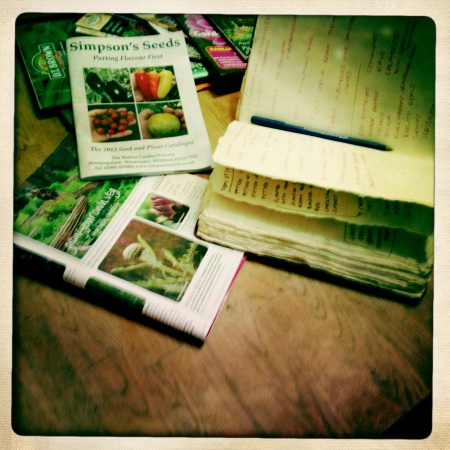One of the most exciting activities in winter for a gardener and vegetable grower has to be planning the year ahead. I have pretty much bought the lion share of my seeds for this year, inevitably I have bought more than I can probably grow realistically, but who isn’t tempted to do the same! I have chosen some different companies this year such as Simpsons, The Real Seed Catalogue, Premier Seeds Direct (eBay), RP Seeds as well as from my regulars such as the Organic Gardening company, Dobies and Suttons. I also pick up seeds here and there in garden centres, this year I found some from Jamie Oliver which I thought I would give a try.
I expect most of us do the same, collecting seed from all over the country, but really is it the best thing to be doing for the biodiversity of our gardens?
When leafing through The Real Seed Catalogue, I came across this excerpt:
Why Not Save Your Own Seed?
Until recently, every gardener in the world saved their own seed. And every gardener was, therefore, a plant breeder. They simply saved the seed of the plants that did best for them, and which they liked most. Although simple, this was efficient.
Each gardener was maintaining a slightly different strain of each vegetable, and this made for a huge living genebank that was very resilient against disease or climate change. If things changed so that your cabbages didn’t do well, someone down the road had a slightly different one that would cope. This has worked very well for the past 11,000 years. That includes the Bronze Age, the building of the Pyramids, the rise and fall of all the major empires. Every year, without even thinking about it, millions of people added to the achievements of their ancestors to maintain and improve the previous years’ varieties. Because their seed was real, open-pollinated seed, every seed was a bit different, so it was widely adapted, but also adaptable – it could cope with all sorts of change.
Now, we have thrown this all away. In the past 40 years, almost all these adaptable local strains have been lost. Gardeners have forgotten how to save their own seed. They are sold hybrids, where every seed is identical, in every packet, year after year – no adaptability for different soils, or for changes in climate over time. And because these hybrid seeds are all the same in every field in every country, people have to bludgeon the environment into some sort of ‘standard’ growing medium with fertilisers and chemicals, to grow their standardised seeds.
Should the climate change, or the supply of cheap oil (to make all these chemicals) dry up, then these hybrids will do badly, and there will be no real seeds left to breed from.
Profits for the seed companies now, but disaster in the future . . . real farming is a project that has been ongoing for millennia, but now in the height of our tiny period of cheap oil, we think we know better and have turned it into just another industrial process. Peoples food should represent stored sunlight and water, but 90% of its calories come from oil these days – for the ploughing, spraying, fertiliser, transport.
When the oil runs out, who will have the real seeds that can grow without it?
There are many interesting points raised here, but the overall message I am stunned by, that we have as a culture dismissed 11,000 years of farming knowledge for ‘progress’ in the past 40 years.
This past week, BBC Radio 4’s Gardener’s Question Time was broadcast from the Seedy Sunday seed swap in Brighton which is pretty local to me in Eastbourne. I was annoyed to have not heard of it, as it would have been the perfect opportunity for me to collect some locally grown seeds that have adapted to our local climate and soil conditions. We should all be doing the same, whether we garden on allotments or at home, we should swap seeds with interested neighbours for our own benefits. Perhaps if we all set up our own local seed swapping service in our local community this practise could be re-established?
But for now, I’ll be swapping seed with my mum! and who knows this may even help our bees as well.






